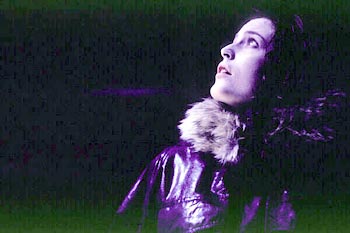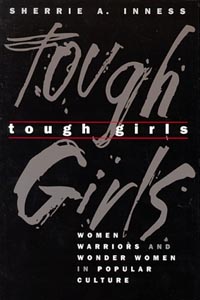![[Metroactive Books]](/books/gifs/books468.gif)
[ Books Index | Metro | Metroactive Central | Archives ]
Amazons of the Airwaves in Print
 The Truth About Gender Is Out There: Sherrie A. Inness notes that Gillian Anderson's Dana Scully has softened with the years. A new study compares the 'Tough Girls' of '70s pop culture with today's hardy heroines By Sarah J. Coleman WHEN I WAS a teenager in the 1970s, I watched countless episodes of Charlie's Angels, The Bionic Woman and The Avengers, marveling at the fact that women in the shows were at last in the driver's seat. These female heroines were as tough as any woman I'd seen, but I also noted that their bosses were male and that karate chops and sharpshooting never once messed up their feminine tresses or glossed lips. In today's popular culture, a teenage girl has an almost bewildering array of tough female icons to draw upon. Whether it's Xena, Warrior Princess emitting her trademark prebattle yodel, Kathryn Janeway piloting Star Trek's Voyager or Dana Scully investigating alien sightings, this new brand of pop culture heroine seems intrepid and fiercely independent. But are these modern "tough girls" really revolutionary or just an instance of old '70s wine packaged in new bottles? Sherrie A. Inness (who, like me, was an aficionado of Charlie's Angels in her youth) sets out to answer this question in Tough Girls: Women Warriors and Wonder Women in Popular Culture. The book is an academic study, but to Inness' credit it doesn't get bogged down with elaborate jargon or lengthy footnotes. The author's arguments are clearly drawn, and themed chapters make her impressive research easy to navigate. Inness begins with a chapter on the 1970s icons who paved the way for today's "tough girls." Without Jaime Sommers (The Bionic Woman), Charlie's Angels and The Avengers' Emma Peel, Inness suggests, there might never have been a Xena or a Scully. And yet the creators of these shows clearly had mixed feelings about how tough their heroines should be. Sommers, for instance, "was able to run 60 miles an hour, yet she also was a beautiful woman who affirmed many stereotypical notions about femininity." Evidently, today's television and the movies have a more progressive outlook. But Inness still finds some heroines not as tough as they first appear. In the case of The X-Files' Scully (Gillian Anderson), she shows how the initial presentation of the FBI agent and doctor as tough and emotionless has been toned down since the show's inception. "By 1996, she was being portrayed in more stereotypically feminine ways," Inness writes. "She has become far more given to emotions traditionally associated with femininity (such as jealousy) than she ever was in the first season, when she was more impersonal in her relationships." For Inness, this muting reflects a societal (read: patriarchal) unease with the portrayal of tough women. Throughout, she gives intriguing examples of how images of tough women have been mediated and softened for public consumption. "When the idea of showing Ripley with a bald pate was first suggested," she writes of the third Alien movie, "the studio conveyed to [Sigourney] Weaver that she would be allowed to be bald only if she appeared attractive. The studio wanted Ripley to be tough, but not so tough that male viewers would not find her sexually desirable."
A less convincing argument for toughness emerges in a chapter on female assassins and desperadoes. For Inness, the fact that Nikita retires from being an assassin at the end of the movie La Femme Nikita demonstrates that "Nikita only thought she was tough." But this definition of toughness seems confined to the question of which character can rack up the highest body count--it conveniently overlooks issues of moral toughness and integrity. For most of the book, Inness works on the assumption that the more ruthless the female heroine, the better the message. Only on the last page does she voice some doubt: "Do we want female characters who are as brutal as the Terminator?" she asks. "Are we hoping to see women who are as merciliess as Dirty Harry?" The knee-jerk answer here is no, but Inness presents the issues in a more complex light. Tough women characters are sassy, clever, heroic, destructive--and sometimes all at once. They affirm female strength, but they can easily be manipulated; the distance from proud Amazon to seductive psychopath is a relatively easy one to breach. But whether--as Inness argues--there's an underlying patriarchal agenda in these kinds of presentations is harder to determine. (After all, if every pop culture heroine were upstanding and morally unimpeachable, we'd be facing one mountain of dull entertainment.) Still, Inness' careful scrutiny of individual heroines is illuminating. She also conveys an infectious enthusiasm for the likes of Ripley, Scully and Xena, and she brings to the fore some lesser-known pop heroines, like the comic-book character Martha Washington. Comparing these characters to Charlie's Angels is a little like putting the iMac next to the 1976 Apple II. Indeed, after reading Tough Girls, I was left feeling mostly positive about the role of tough women in today's media, though more conscious of compromises in their presentation. As Inness implies, we've come a long way, even if it pays to stay vigilant. Like Kathryn Janeway, today's tough women characters may be piloting the ship, but they're still a ways from home.
Tough Girls: Women Warriors and Wonder Women in Popular Culture by Sherrie A. Inness; University of Pennsylvania Press; 228 pages, $19.95. [ San Jose | Metroactive Central | Archives ]
|
From the January 28-February 3, 1999 issue of Metro.
Copyright © Metro Publishing Inc. Maintained by Boulevards New Media.
 ONE HEROINE who wins her unqualified approval is Xena, Warrior Princess. Critics of the show have complained that its heroine is nothing more than "the chick in the brass bra," but Inness disagrees. In a chapter devoted to the Amazon avenger, she enthuses over the way that "the program emphasizes the physical toughness of not only Xena but women in general" by having many strong women characters.
ONE HEROINE who wins her unqualified approval is Xena, Warrior Princess. Critics of the show have complained that its heroine is nothing more than "the chick in the brass bra," but Inness disagrees. In a chapter devoted to the Amazon avenger, she enthuses over the way that "the program emphasizes the physical toughness of not only Xena but women in general" by having many strong women characters.